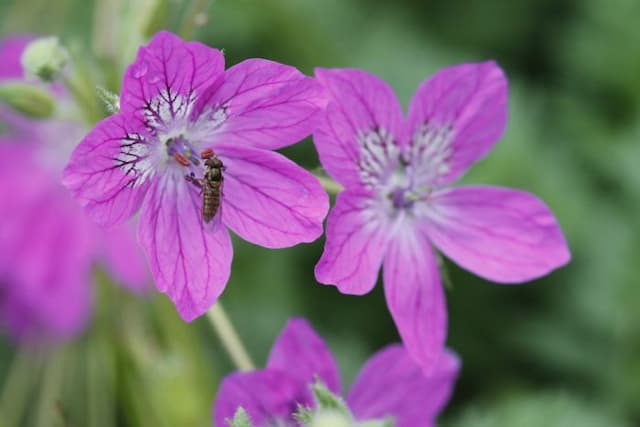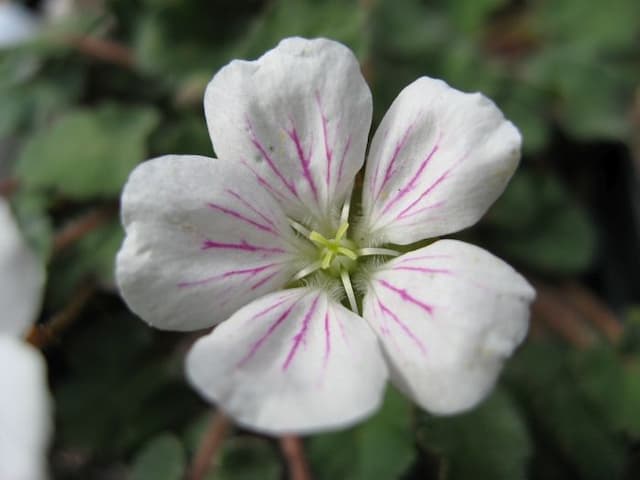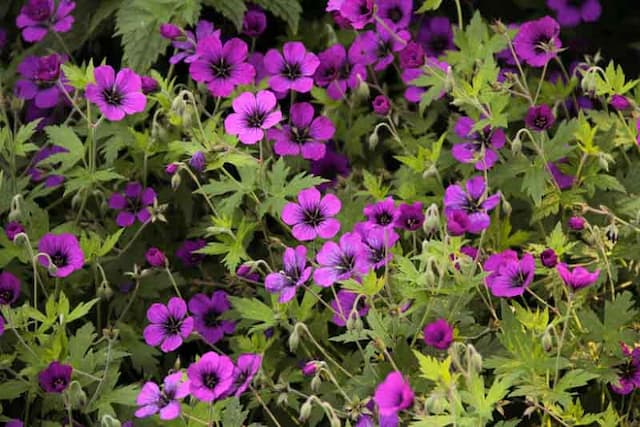Geranium Pelargonium 'Carisbrooke' (R)

ABOUT
Pelargonium 'Carisbrooke' is adorned with striking flowers that generally display a rounded shape and are clustered in groups that give a showy display. The blooms exhibit vibrant colors, often with two-toned patterns that blend shades of pinks, reds, or purples, usually with darker markings on the petals that add to their intricate beauty. The foliage of this plant is equally attractive, typically composed of lush, green leaves that have a unique zonal pattern, which often appears as darker green circular marks on the leaves. The leaves themselves may have a rounded or slightly scalloped edge, giving them a soft, aesthetic appeal. Depending on the specific variety, the foliage can sometimes carry a fragrant scent when touched or brushed against, releasing pleasant aromatic oils. Overall, Pelargonium 'Carisbrooke' has a bushy, mounding form that makes it ideal for ornamental display in gardens or containers, where its vibrant blossoms and attractively patterned foliage can be showcased.
About this plant
 Names
NamesFamily
Geraniaceae.
Synonyms
Scented Geranium, Rose Geranium, Sweet Scented Geranium, Pelargonium.
Common names
Pelargonium 'Carisbrooke'
 Toxicity
ToxicityTo humans
Pelargonium 'Carisbrooke', commonly known as a type of Geranium, is not known to be highly toxic to humans. However, ingestion of large amounts of the plant may cause mild symptoms such as gastrointestinal discomfort, nausea, vomiting, or diarrhea. Direct contact with the skin may sometimes result in dermatitis for sensitive individuals.
To pets
Geraniums, including Pelargonium 'Carisbrooke', are known to be toxic to pets, particularly dogs and cats. If ingested, the plant can cause symptoms such as vomiting, anorexia, depression, and dermatitis. In more severe cases, ingestion may also lead to kidney failure or other serious health issues, so it is important to keep these plants out of reach of pets and seek veterinary care if they are suspected to have ingested any part of a Geranium.
 Characteristics
CharacteristicsLife cycle
Perennials
Foliage type
Evergreen
Color of leaves
Varies
Flower color
Mixed
Height
1 feet 6 inches (46 cm)
Spread
1 feet 6 inches (46 cm)
Plant type
Herb
Hardiness zones
Varies
Native area
South Africa
Benefits
 General Benefits
General Benefits- Decorative Appeal: Pelargoniums are known for their vibrant blooms and diverse foliage, adding color and beauty to gardens and indoor spaces.
- Drought Resistance: As a succulent plant, it is well-suited to withstand dry conditions and require less frequent watering.
- Easy to Propagate: Pelargoniums can be easily propagated from cuttings, allowing gardeners to create new plants for free.
- Long Flowering Period: They often have a long blooming season, providing flowers from spring through fall in favorable conditions.
- Low Maintenance: This plant is relatively undemanding, requiring minimal pruning and care once established.
- Versatility: Suitable for containers, borders, and as houseplants, pelargoniums can be grown in a variety of settings.
- Pest Resilient: They are generally resilient to pests, reducing the need for chemical treatments.
- Attracts Pollinators: The flowers can attract beneficial insects such as bees and butterflies to the garden.
- Variety of Uses: Pelargoniums can be used in landscapes, hanging baskets, or as a fragrant plant depending on the variety.
- Adaptable: They are adaptable to a range of soil types and environmental conditions.
 Medical Properties
Medical PropertiesThis plant is not used for medical purposes.
 Air-purifying Qualities
Air-purifying QualitiesThis plant is not specifically known for air purifying qualities.
 Other Uses
Other Uses- As a natural dye: The vibrant petals of geraniums can be used to create natural dyes for fabrics, art, and crafts.
- In potpourri: Dried geranium leaves and flowers can add a pleasant fragrance to homemade potpourri blends.
- As a floral preservative: Geranium leaves can be added into water to help extend the life of cut flowers by providing antibacterial properties.
- As an insect repellent sachet: Crushed geranium leaves can be placed in sachets to ward off insects in cupboards or drawers.
- In culinary delights: Some geraniums have edible flowers and can be used as a decorative, flavorful addition to salads, desserts, and drinks.
- As a bookmark: Dried geranium leaves, due to their pleasant scent and flat nature, make unique and aromatic bookmarks.
- In crafts: Geranium leaves and flowers can be pressed and used in creating botanical art pieces or in paper making.
- For scent layering in gardens: Planting geraniums amongst other unscented plants can add a layer of olfactory interest in landscape design.
- In ice cubes: Freeze small geranium petals in ice cubes to add a touch of elegance and flavor to beverages.
- As a writing tool: The stems of some geraniums can be hollowed out and used as makeshift quills for ink writing or as styluses for tablets with resistive touchscreens.
Interesting Facts
 Feng Shui
Feng ShuiThe Geranium is not specifically used in Feng Shui practice.
 Zodiac Sign Compitability
Zodiac Sign CompitabilityThe Geranium is not used in astrology practice.
 Plant Symbolism
Plant Symbolism- Comfort: Pelargoniums, commonly known as "geraniums," are often associated with comfort because they have a familiar and soothing presence in home gardens.
- Healing: Geraniums have been used in traditional medicine and are believed to symbolize healing and the promotion of health.
- Friendship: With their welcoming appearance and ease of care, geraniums are thought to represent friendship and positive relationships.
- Good Luck: In some cultures, geraniums are carried or grown as a token of good luck and to ward off negative energies.
- Longevity: As geraniums are robust and can bloom for an extended period, they are sometimes symbolic of longevity and enduring qualities.
 Water
WaterGeraniums, including the Pelargonium 'Carisbrooke', should be watered thoroughly when the top inch of soil feels dry to the touch. In general, this may mean watering once every 1-2 weeks, but the frequency can vary depending on environmental conditions such as temperature and humidity. It's important to not let geraniums sit in waterlogged soil, so make sure pots have drainage holes. When you water, add enough water so that it runs out of the drainage holes—this might be approximately 16-32 ounces for a medium-sized pot. During the hot summer months, the plants may need water more frequently, while in the winter, they will require less.
 Light
LightGeraniums prefer bright, indirect sunlight and will thrive best in a spot that receives at least 4-6 hours of sunlight daily. An east- or west-facing windowsill is ideal, providing the plant with the morning or afternoon sun, respectively. However, they should be protected from the harsh midday sun, which can scorch their leaves.
 Temperature
TemperatureGeraniums are comfortable in a range of temperatures, but they prefer to live in an environment that's between 65 and 75°F. They can tolerate temperatures as low as 55°F and as high as 80°F, but they should be protected from frost and extreme heat. Ensuring good air circulation around the plant can also help prevent disease and keep it healthy.
 Pruning
PruningPruning geraniums encourages bushier growth and more blooms. Pinch off the stem tips and remove yellowing leaves or spent flowers throughout the growing season to promote new growth. The best time for more extensive pruning is in late winter or early spring. Pruning can be done every few months or as needed to maintain shape and vigor.
 Cleaning
CleaningAs needed
 Soil
SoilThe best soil mix for a Scented Geranium (Pelargonium 'Carisbrooke') is well-draining and fertile, with added organic matter such as peat or compost. A potting mix designed for cacti can work well. Aim for a slightly acidic to neutral pH, between 6.0 and 7.0.
 Repotting
RepottingScented Geraniums should be repotted every 1-2 years to refresh the soil and accommodate root growth. Spring, before active growth begins, is the ideal time for repotting.
 Humidity & Misting
Humidity & MistingScented Geraniums prefer moderate to low humidity levels, typical of indoor environments. Avoid high humidity to prevent leaf and stem diseases.
 Suitable locations
Suitable locationsIndoor
Place in bright indirect light and well-draining soil.
Outdoor
Sunny spot, well-draining soil, protect from frost.
Hardiness zone
9-11 USDA
 Life cycle
Life cycleThe life cycle of the Pelargonium 'Carisbrooke' (Regal geranium) begins with seed germination, which occurs in a warm, moist soil environment, usually in the spring or when conditions are suitable in controlled environments. The seedlings emerge and grow into juvenile plants, developing a root system and foliage as they mature. As they enter the vegetative stage, these geraniums grow leaves and stems but do not yet produce flowers. Once the plant reaches maturity and environmental conditions are favorable, it enters the flowering stage, producing vibrant blooms that attract pollinators and contribute to the plant's aesthetic value. After pollination, the flowers produce seeds, concluding the reproductive stage. Eventually, if conditions are not ideal or due to seasonal changes, the plant may enter dormancy or die, and the seeds start a new life cycle when conditions become favorable again.
 Propogation
PropogationPropogation time
Spring-Early Summer
Pelargonium 'Carisbrooke', commonly known as geranium, is best propagated through stem cuttings. This method is usually performed in late summer to early fall, providing optimal conditions for rooting and new growth. To propagate by cuttings, a healthy stem about 4 to 6 inches (10 to 15 centimeters) long is selected. The cutting should comprise several leaves and be taken just below a leaf node, where the concentration of hormones is high, which encourages rooting. Leaves on the lower half of the stem are removed to prevent rot and the cutting is allowed to dry for a few hours to form a callus on the cut end. The prepared cutting is then inserted into a moist potting mix with good drainage. The pot must be placed in a warm area with bright, indirect light and covered with plastic to maintain high humidity until roots have developed, typically within a few weeks.









![Cranesbill [Rothbury Gem]](/_next/image?url=https%3A%2F%2Fplants-admin.emdemapps.com%2Fimages%2Fplants%2F%2Fimages%2F604b6243984c2.png&w=640&q=75)